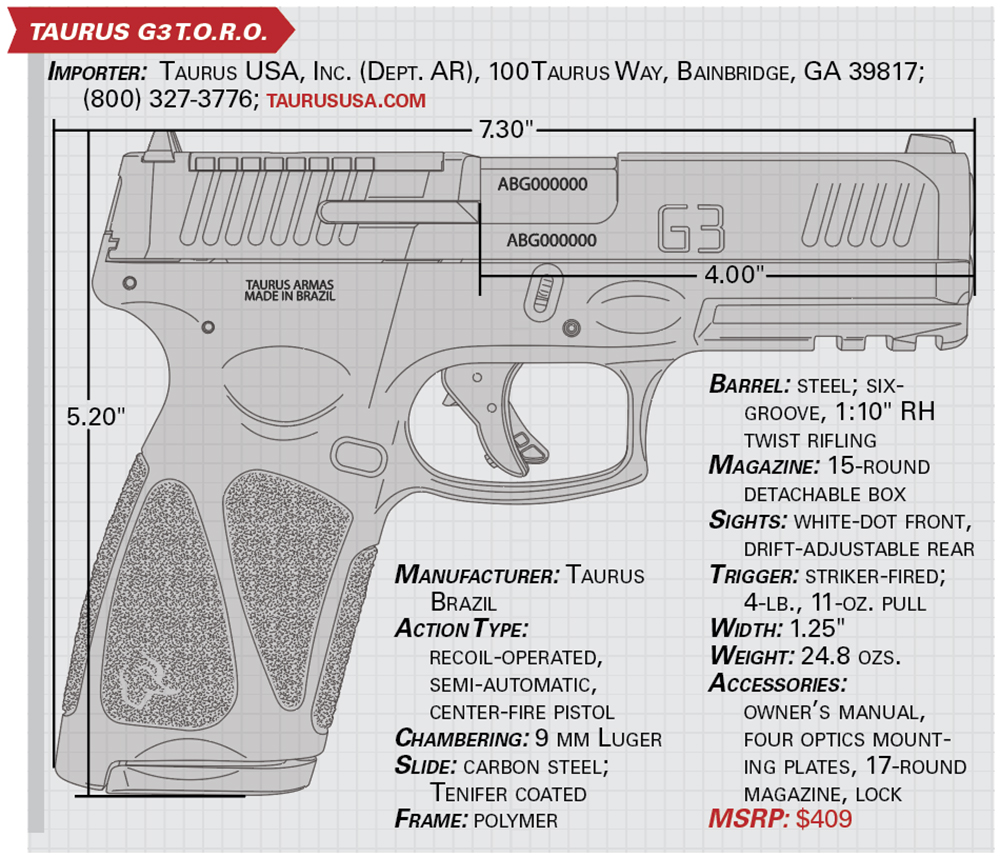
In 2019, Taurus Int’l made the business decision to set aside the company’s more unusual and exotic offerings. Instead, the team focused its efforts on improving product quality and manufacturing consistency while continuing to offer reliable handgun options that met its customers’ needs at affordable prices. Among the top offerings that year was the TX22, an innovative, increased-capacity, .22 Long Rifle-chambered pistol. The company also upgraded its compact polymer-frame defensive 9 mm pistol offerings with the release of the G3 series. I had an opportunity to test both models that year with positive results.
Since that time, the industry has seen a sharp rise in the demand for pistols that leave the factory with slides ready to accept micro red-dot (MRD) optics. The use of MRDs is becoming a popular option in defensive circles because the technology is now reliable and affordable, while the sight picture these small reflex optics provide is fast to acquire and intuitive to use in most lighting conditions. Using proper shooting techniques, most shooters are able to print tighter groups downrange with red-dot optics than with traditional iron-sight systems. As a result, just as integral dustcover accessory rails for lights and laser modules became a “must-have” for defensive semi-automatics two decades ago, optics-ready is quickly becoming the next standard for concealed-carry, home-defense and target-shooting handguns.
Recognizing the importance of accommodating the red-dot trend, Taurus has introduced new optics-ready models as part of the company’s 2021 lineup. The G3 series of pistols now includes Taurus Optics Ready Option (T.O.R.O.) models that ship with a well-thought-out set of mounting hardware (see Senior Executive Editor Kelly Young’s story on mounting red-dots on p. 54). Adding a reflex sight to the TX22 rimfire pistol took a bit more work, but the result is the new TX22 Competition model.
TX22 Competition
The standard version of the TX22 is a blowback-operated semi-automatic that has proven to be reliable with a variety of .22 Long Rifle ammunition. That’s no mean feat considering how ammunition-sensitive some rimfire pistols can be—so making changes to the platform that might impede its reliability was a real concern.
Defensive, center-fire pistols with steel slides machined to accept red-dot optics are, generally, not adversely affected by modest variations in slide weight. Most 9 mm Luger ammunition generates enough recoil to cycle such pistols reliably with or without an optic mounted.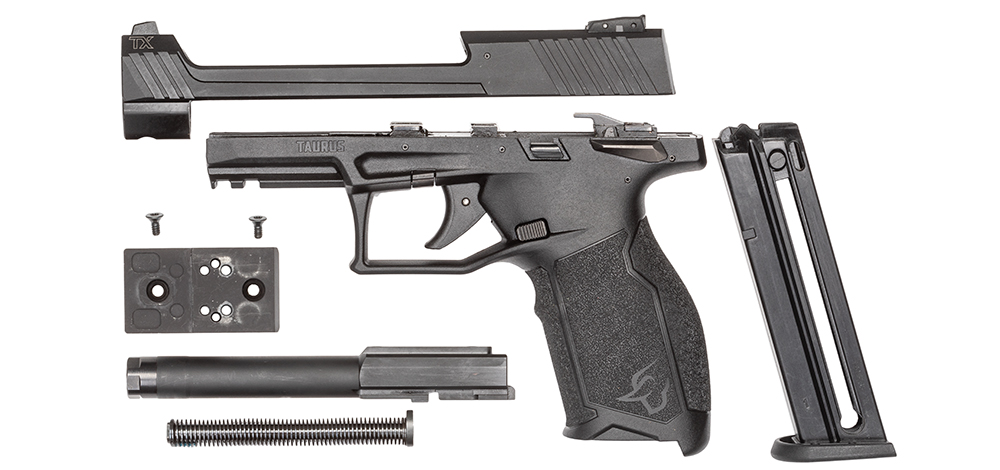
The original gun’s polymer guide rod has been replaced by a full-length steel rod with a captured, flat-wire spring on the TX22 Competition, but the new pistol is otherwise functionally identical to the standard TX22.
The TX22 rimfire is a different story. The lightweight slide assembly is made primarily of aluminum, with some polymer and steel inserts. It weighs in at just 4.1 ozs., which is a good fit for the reduced pressure levels produced by .22 Long Rifle cartridges. But, depending on the optic used, attaching a red-dot and the required hardware could nearly double the weight of the slide. Of course, not all optics weigh the same amount, which would make tuning the recoil spring a tricky business.
To resolve the problem, the company’s engineers decided to take full advantage of the TX22’s locked-barrel design. Unlike many center-fire pistols, the barrel of the TX22 does not shift its position within the slide and frame when the action is cycled. Instead, the barrel is locked in place against the same aluminum block that supports the pistol’s takedown-lever extension and two of the three sets of short slide rails. This provides the stability of a frame-mounted barrel while allowing it to be easily removed along with the slide for cleaning. It also provides the foundation needed to support an optic and mounting system with the right modifications.
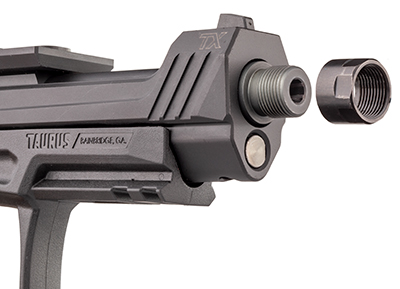 At the heart of the TX22 Competition is a new bull barrel configured with target shooting in mind. The length and diameter have been increased from 4.1" to 5.25" and 0.40" to 0.60", respectively. Designers eliminated the need for a muzzle-device adapter with this model by extending the threaded barrel 0.25" past the nose of the slide. A thread protector is provided. The original polymer guide rod has been replaced with a full-length steel rod with a captured, flat-wire spring.
At the heart of the TX22 Competition is a new bull barrel configured with target shooting in mind. The length and diameter have been increased from 4.1" to 5.25" and 0.40" to 0.60", respectively. Designers eliminated the need for a muzzle-device adapter with this model by extending the threaded barrel 0.25" past the nose of the slide. A thread protector is provided. The original polymer guide rod has been replaced with a full-length steel rod with a captured, flat-wire spring.
The squared-off portion of the barrel around the chamber has been lengthened from 1.5" to 2.1" to support a 1.2"-wide and 2.15"-long steel scope base. This removable base is secured to the barrel via two Torx-head screws. The front half of the base is milled to accept a pair of reversible mounting plates that are provided with the gun, while the rear half of the mount sports three sets of screw ports. The plates and ports allow for four different configurations to accommodate a variety of red-dot optics, including models manufactured by Burris, C-More, Docter, Holosun, Leupold, Sightmark and Trijicon.
The TX22 Competition’s aluminum slide retains the same styling as the original, but it has been lengthened by 0.90". It has a topside cutout that reaches from just behind the polymer white-dot front sight to the rear of the ejection port. This cutout accommodates the scope mount and reduces the longer slide’s weight to 4.5 ozs., which is nearly the same as the standard model. There’s still a set of canted cocking serrations at the front of the slide, as well as the rear, but the number of cuts up front has been reduced from five to three. The white-dot rear sight remains fully adjustable for elevation and windage. It should be noted that the sights are of standard height, which means they are too short to be viewed through or co-witnessed with the optic.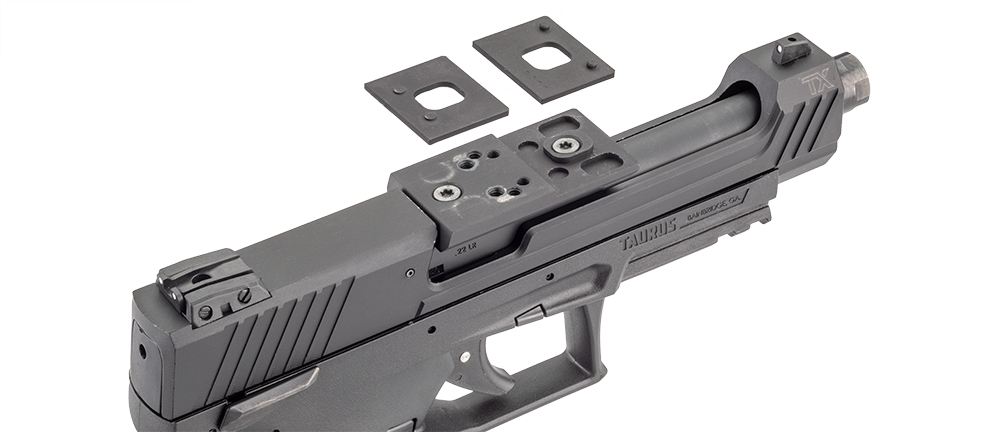
A pair of reversible mounting plates ships with the TX22 Competition, which, when used in conjunction with a steel optics base affixed to the pistol’s bull barrel, allows for the installation of a wide variety of micro red-dots.
Changes to the barrel and slide assembly have increased the pistol’s weight from 17.4 ozs. to 23 ozs. before mounting an optic. Nevertheless, the pistol still has a light, handy and well-balanced feel. As for the lower half of the gun, it remains unchanged from the standard model. This is a good thing, since the sage advice of, “If it ain’t broke, don’t fix it” applies in this case.
The textured polymer frame’s features and controls have been configured to mimic those commonly found on popular striker-fired 9 mm pistols. A 1.75" accessory rail is molded into the dustcover for light and laser modules. Trigger finger rest indentations are located intuitively just above the trigger, and the trigger guard is shaped to act as a finger rest at its front and is recessed where it meets the grip. A smooth-faced, hinged trigger shoe takes the place of an integral trigger-safety lever. The grip features moderate, molded-in, wraparound texturing that is effective without being abrasive. Two of Taurus’ proprietary 16-round polymer magazines ship with the gun.
I outfitted the TX22 Competition with a Holosun HS407C red-dot for informal and formal testing at the shooting range and shot it using .22 Long Rifle cartridges topped with 40-gr. bullets with listed rifle velocities ranging from a relatively sedate 1,070 f.p.s. to a more toasty 1,435 f.p.s. These rifle speeds translated into pistol muzzle velocity averages ranging from 946 f.p.s. to 1,129 f.p.s. Despite the changes in bullet velocities, this version of the TX22 ran just as reliably as its predecessor. It exhibited no malfunctions of any kind during the course of testing.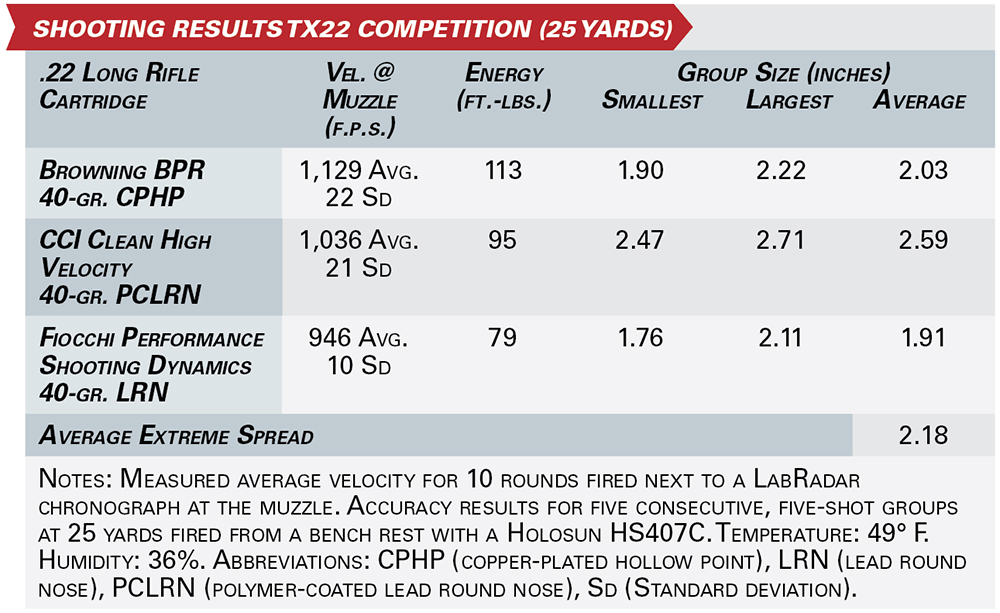
Thanks to the smooth 4-lb., 12-oz., trigger, bull barrel and Holosun optic, punching paper targets was a real pleasure. Generally speaking, my experience has been that using a red-dot optic can shave somewhere around a half-inch off of my group sizes at 25 yards when compared to the same, or similar, handguns aimed with traditional iron sights. The TX22 Competition did even better than that. The standard model printed an average extreme spread of 2.98" at 25 yards when I tested it; the Competition yielded an average extreme spread of 2.18".
Overall, the American-made TX22 Competition exhibited a clean, professional level of fit and finish throughout, which is consistent with what I saw in the standard model. This is a very likable pistol that’s a great fit for a variety of hand shapes and skill levels. The target-grade modifications increase the sticker price by about $170 when compared to the suggested retail price of the standard version, but the improved performance and its usefulness as a rimfire understudy to optics-ready defensive pistols make it a worthwhile investment. Although .22 Long Rifle pistols are a less-than-optimal choice, there are those who have their reasons for turning to a rimfire handgun for personal protection inside or outside of their homes. If I were limited to a .22 pistol for self-defense, this one would be at the top of the list.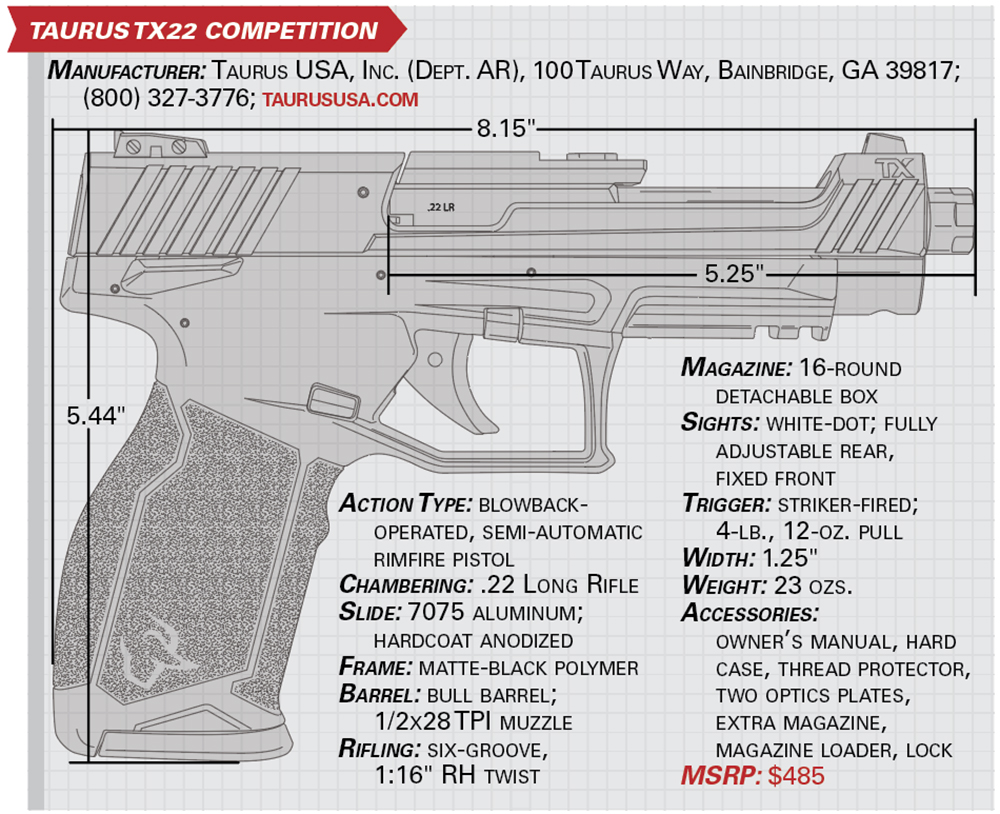
G3 T.O.R.O
Modifying the G3 striker-fired, polymer-frame pistol for red-dot optics was a fairly straightforward process when compared to the TX22. Manufactured in Brazil, this 9 mm semi-automatic is outfitted with a short-recoil, locked-breech action and a carbon steel slide. This ammunition-and-slide configuration allows for a 2"-long section of the slide’s top edge—between the rear sight and the ejection port—to be milled, drilled and tapped so that the mounting plate and optic can be attached directly to it.
Along with the slide cut, the T.O.R.O. arrives from the factory with a full set of mounting hardware. This set includes four baseplates and three sets of screws that accommodate a host of red-dot optics. Keeping track of which parts go with which option would be a bit confusing if not for the easy-to-read compatibility chart included in the owner’s manual. With that chart in hand, it only took a few minutes to remove the factory-installed filler plate from the slide and install the Holosun HS507C that was used throughout the testing process.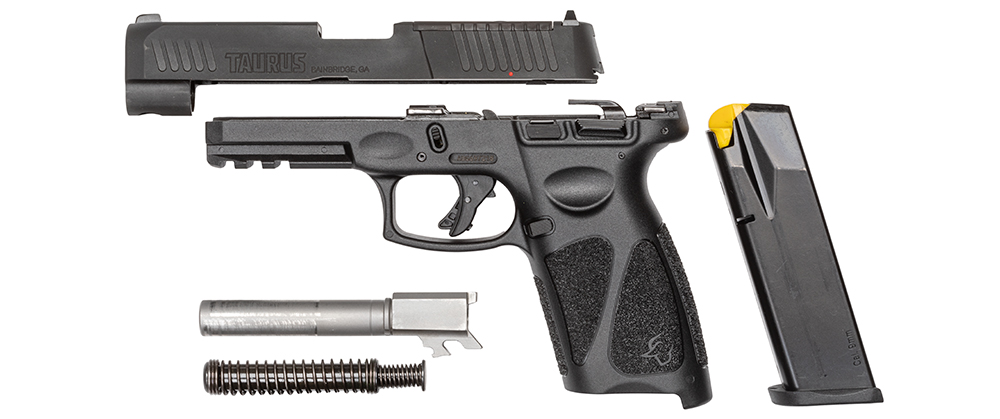
Cosmetics and the configuration of controls on the G3 T.O.R.O. remain the same as on previous models. The carbon steel slide features a matte-black Tenifer finish, front and rear cocking serrations with a beveled nose up front and a back end contoured to match the frame. The ejection port is also beveled to aid spent cartridge cases in clearing the action, and it’s outfitted with an oversize extractor claw. The standard-height sights have been upgraded from polymer to steel, with a pinned white-dot sight in front and a dovetailed, serrated, square-notch sight at the rear.
Removing the slide from the frame reveals an interior configuration that takes its cues from the Glock Safe Action school of handgun design. The 4" stainless steel barrel’s chamber features a witness hole at the top of the chamber, which acts as a loaded-chamber indicator, and traditional land-and-groove rifling. The recoil assembly captures two round-wire recoil springs wrapped around a sleeved steel guide rod.
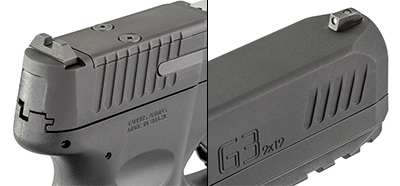
The polymer frame’s dustcover features a molded-in 2" accessory rail with a serial-number plate. The same number is engraved in three more locations: the slide’s ejection port, the barrel’s chamber and the left side of the frame just above the trigger. On either side of the frame just behind the rail are indentations that act as finger rests when the trigger finger is held out straight against the frame. Behind these dimples is the steel takedown lever.
The face of the trigger guard is curved to act as a finger rest and is recessed where it meets the grip frame. The lightly grooved polymer trigger features an oversize integral safety lever and an unusual second-strike capability. With most striker-fired pistol configurations, the slide has to be manually cycled to reset the striker if it lands on a hard primer. The G3 is configured so that the trigger can be pulled a second time to ignite a stubborn primer without cycling the slide.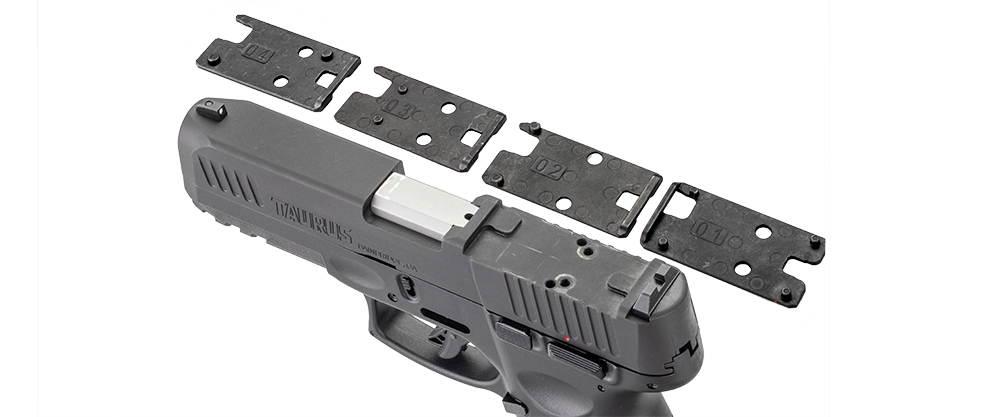
Other external controls are also metal and are all located on the left side of the frame, including a low-profile slide stop, a grooved manual thumb safety and a smooth magazine-release button. At the top of the grip frame are molded-in thumbrest indentations, which contribute to a more intuitive grip fit.
Just how much texturing is required to provide enough purchase for a defensive pistol remains a topic of debate. For the G3 pistols, Taurus opted to go with a more aggressive approach. The grip frame features a total of six irregularly shaped panels of grit-like texturing on par with sandpaper or skateboard tape. It’s a highly effective choice, especially for gloved, wet or cold hands. However, it can be abrasive to work with for extended practice sessions, which is why I opted to wear a glove at the shooting range.
The G3 does not have an interchangeable backstrap, likely as a cost-saving measure. The sides of the magazine well, along with the magazine baseplates, are dimpled to allow the magazine base to be gripped and ripped from the pistol, if needed. The fixed backstrap features a short extension at the base to protect the shooting hand from getting pinched by the magazine during quick reloads. This model ships with two, blued steel magazines. One is a flush-fit model that holds 15 rounds; the other is a slightly extended 17-round version with a fitted polymer sleeve that acts as a grip extension. The G3 does not have a magazine safety.
One of the reasons I was looking forward to this workout at the range with another G3 pistol is the pistol’s trigger. Some striker-fired polymer pistols, especially budget-priced models, can have triggers that feel mushy or gritty or exhibit a somewhat vague break. The G3’s trigger has a smooth, light take-up with a firm stop just before breaking cleanly at 4 lbs., 11 ozs. A lighter trigger makes the gun more comfortable to work with, but it’s not so light as to be too light for carry. The trigger reset is short and crisp, with a tangible and audible click.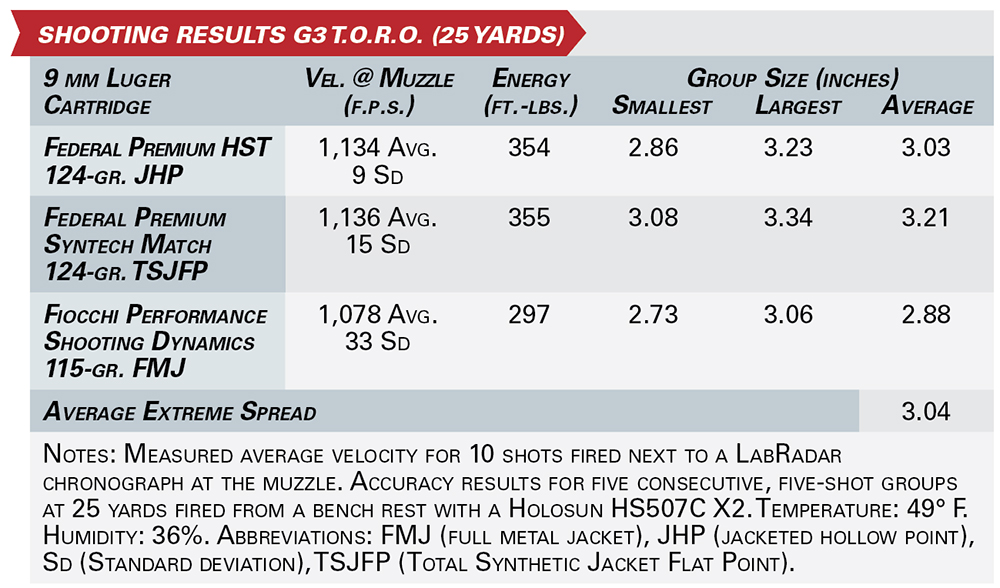
This version of the G3 proved to be as reliable as the previous model I worked with. There were no malfunctions, mechanical or ammunition-related, in the course of informal and formal testing. It ticked along smoothly with a mix of practice- and premium-grade ammunition. As expected, taking advantage of the T.O.R.O. system to mount a Holosun optic to this pistol contributed to reduced group sizes downrange. When I conducted the bench-rested, five-shot-group accuracy testing of the iron-sights-only version of the G3, I managed to tap out an average extreme spread of 3.50" at 25 yards. Using a red-dot moved the average extreme spread down to 3.04".
I certainly will not knock anyone’s choice to spend as much money as they want to on their concealed carry rig. However, the Taurus G3 series of polymer-frame 9 mm pistols are good examples of semi-automatics that can get the job done without breaking the bank. Purchasing the T.O.R.O. version of this gun increases its cost by $100 for a suggested retail price of $409, but that’s still hundreds of dollars less than some of Taurus’ non-optics-ready competitors. Overall, it’s an affordable, dependable, red-dot-compatible option for self-defense. And, if you’re looking for a subcompact pistol for concealed carry, Taurus recently released the G3c in a T.O.R.O. configuration.